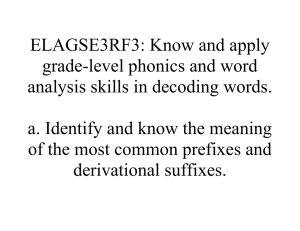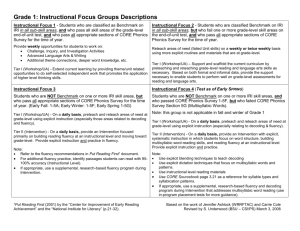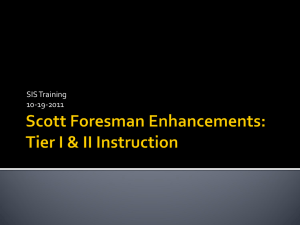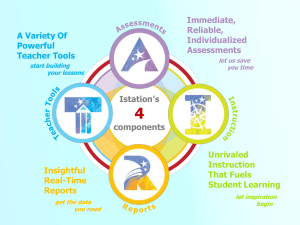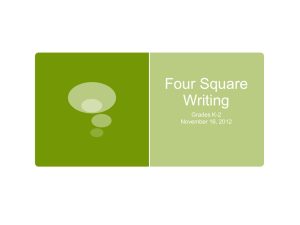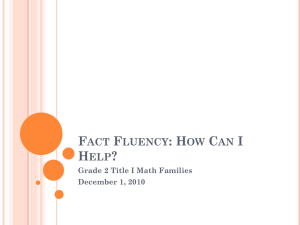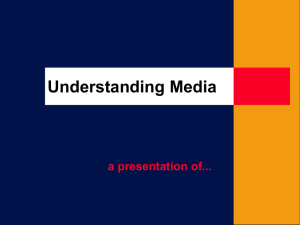Workshop Overview Linking Assessments to Interventions
advertisement
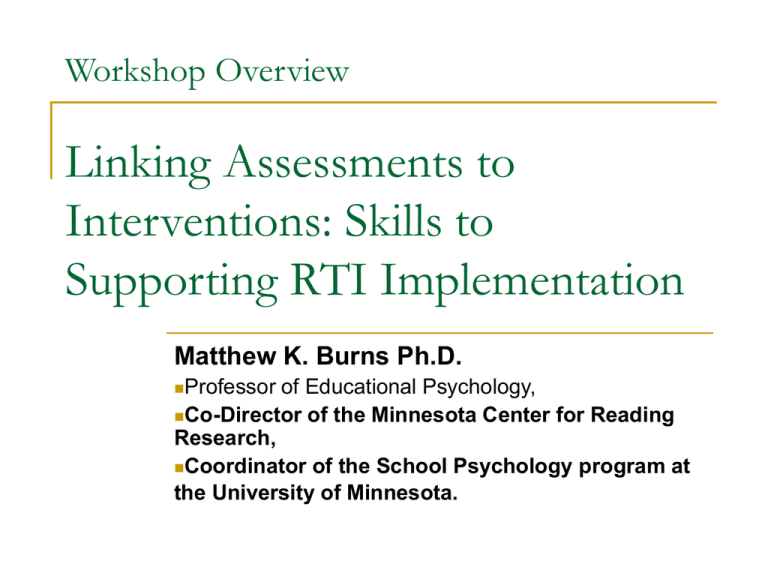
Workshop Overview Linking Assessments to Interventions: Skills to Supporting RTI Implementation Matthew K. Burns Ph.D. Professor of Educational Psychology, Co-Director of the Minnesota Center for Reading Research, Coordinator of the School Psychology program at the University of Minnesota. TIER Problem Solving Tier I – Identify discrepancy between expectation and performance for the class or individual (Is it a classwide problem?) Tier II – Identify discrepancy for individual. Identify category of the problem. (What is the category of the problem?) Tier III - Identify discrepancy for individual. Identify causal variable. (What is the causal variable?) Multi-Tiered Academic Intervention – Tier I Universal screening and progress monitoring with quality core curriculum: ALL students Question to ask- Is this a classwide problem? Reading Instruction in Elementary School Two hours each day (90 minutes core; 30 minutes supplemental) Explicit instruction Free-choice reading Word study Writing Resources - National Reading Panel Google; free – Resource for what effective teachers do Resources Classwide Need and Instructional PLC What do highly effective teachers do? What do we as a TEAM do? How will we know if it works? - What data can we collect? (outcome) - For what will we look? (process) What will we do next? - What is the implementation plan? Math Assessment - Screening Measures of early numeracy - oral counting - missing number - number identification - quantity discrimination Monitoring Basic Skills Progress - math computation - math application Math Assessment – Screening (cont.) Star Math Multi-skill computation probe - www.mathfactcafe.com - 25 problems - skill by columns - 4 minutes Math Assessment – Screening (cont.) Standard Instructional Level - 14 DCPM among 2nd and 3rd graders - 24 DCPM among 4th and 5th graders Proficiency Level - 17 DCPM among 2nd and 3rd graders - 29 DCPM among 4th and 5th graders ELA Screening - Kindergarten Phonemic Awareness - Initial Sound Fluency; ISP - Phonemic Segmentation Fluency; PSF - Rhyme - Initial sound deletion ELA Screening – Kindergarten (cont.) Letter Knowledge - Naming letters Fluency; LNF Graphophonemic Knoweldge - Letter Sound Fluency; LSF - Nonsense Word Fluency; NWF (also decoding) ELA Screening – Other Grades First Grade - word list - spelling - reading fluency Second through Sixth grades - reading fluency at grade level You have the data? Now what? Intervention plan – 15 minutes per day Protocol-based classwide peer tutoring Model, Guided practice, Independent Timed Practice with delayed error connection Math Scan papers for high error rates Do 5-min. re-teach Provide applied practice using mastery-learning Classwide Intervention http://kc.vanderbilt.edu/pals/ Grade level Team Meeting - Benchmark Is there a classwide need? Who needs Tier 2? Did we miss anyone? What should we do for Tier 2? Should we go Tier 3? Multi-Tiered Academic Intervention – Tier II Standardized interventions with small groups in general education: 15% to 20% of students at a time Question to ask- What category is the deficit? Assess 4 NRP Areas Phonemic Awareness - Phoneme segmentation fluency Phonics - Nonsense word fluency (WJ Pseudoword) Fluency - Oral fluency (TOSCRF) Vocabulary/Comprehension Florida Center for Reading Research www.fcrr.org Click – For teachers Click – Interventions for Struggling Readers Click – Supplemental and Intervention Programs http://www.fcrr.org/FCRRReports/CReportsCS.aspx?rep=supp ELA Standards Reading Foundational Skills Phonics and Word Recognition K.3 Know and apply grade-level phonics and word analysis skills in decoding words. a. Demonstrate basic knowledge of one-to-one letter-sound correspondences by producing the primary … 1.3 Know and apply grade-level phonics and word analysis skills in decoding words. a. Know the spelling-sounds correspondences for common consonant … 2.3 Know and apply grade-level phonics and word analysis skills in decoding words. a. Distinguish long and short vowels when reading regularly spelled … 3.3 Know and apply grade-level phonics and word analysis skills in decoding words. a. Identify and know the meaning of the most common prefixes … 4.3 Know and apply grade-level phonics and word analysis skills in decoding words. a. Use combined knowledge of all letter-sound correspondences, syllabication patterns, and morphology … 5.3 Know and apply grade-level phonics and word analysis skills in decoding words. a. Use combined knowledge of all letter-sound correspondences, syllabication patterns, and morphology … Math Elementary - Work backwards in curriculum to find instructional level - Practice with procedural Operations and Algebraic Thinking K.OA.1 Represent addition and subtraction facts with objects … 1.OA.1 Use addition and subtraction within 20 to solve word problems …. 2.OA.1 Use addition and subtraction within 100 to solve one- and two- step word problems …. 3.OA.1 Interpret products of whole numbers, e.g., interpret 5 x 7 as the total number of objects in groups of 5 of 7 objects … 4.OA.1 Interpret a multiplication equation as a comparison, e.g., interpret 35 = 5 x 7 as a statement that 35 is 5 times as many as 7 … 5.OA.1 Use parentheses, brackets, or braces in numerical expressions, and evaluate expressions with these symbols. Multi-Tiered Academic Intervention – Tier III Individual interventions with in-depth problem analysis in general education: 5% of students at any time Intensive problem Analysis? Instructional Level/ Instructional match Sufficient prior knowledge & skill to successfully interact with the task while still learning new information Match: student skill + instructional material = important functional variable for stedent learning within RTI Math Instructional Hierarchy Phases for Learning for Math Conceptual Acquisition Proficiency Generalization Acquisition Proficiency Adaption Procedural Generalization Adaption Comprehension ELA Instructional YES START HERE Assess Fluency Hierarchy Fluent? (ORF) NO Assess Phonetic Skills Adequate? (LSF, NWF) Fluency Intervention YES Accuracy or Proficiency NO Assess Phonemic Skills Adequate? (PSF, ISF, CTOPP) YES NO Phonemic Awareness Intervention Phonics Intervention Accuracy or Proficiency http://usm.maine.edu/sehd/future/ •videos http://www.gosbr.net/ • reading, writing, math interventions •progress monitoring
